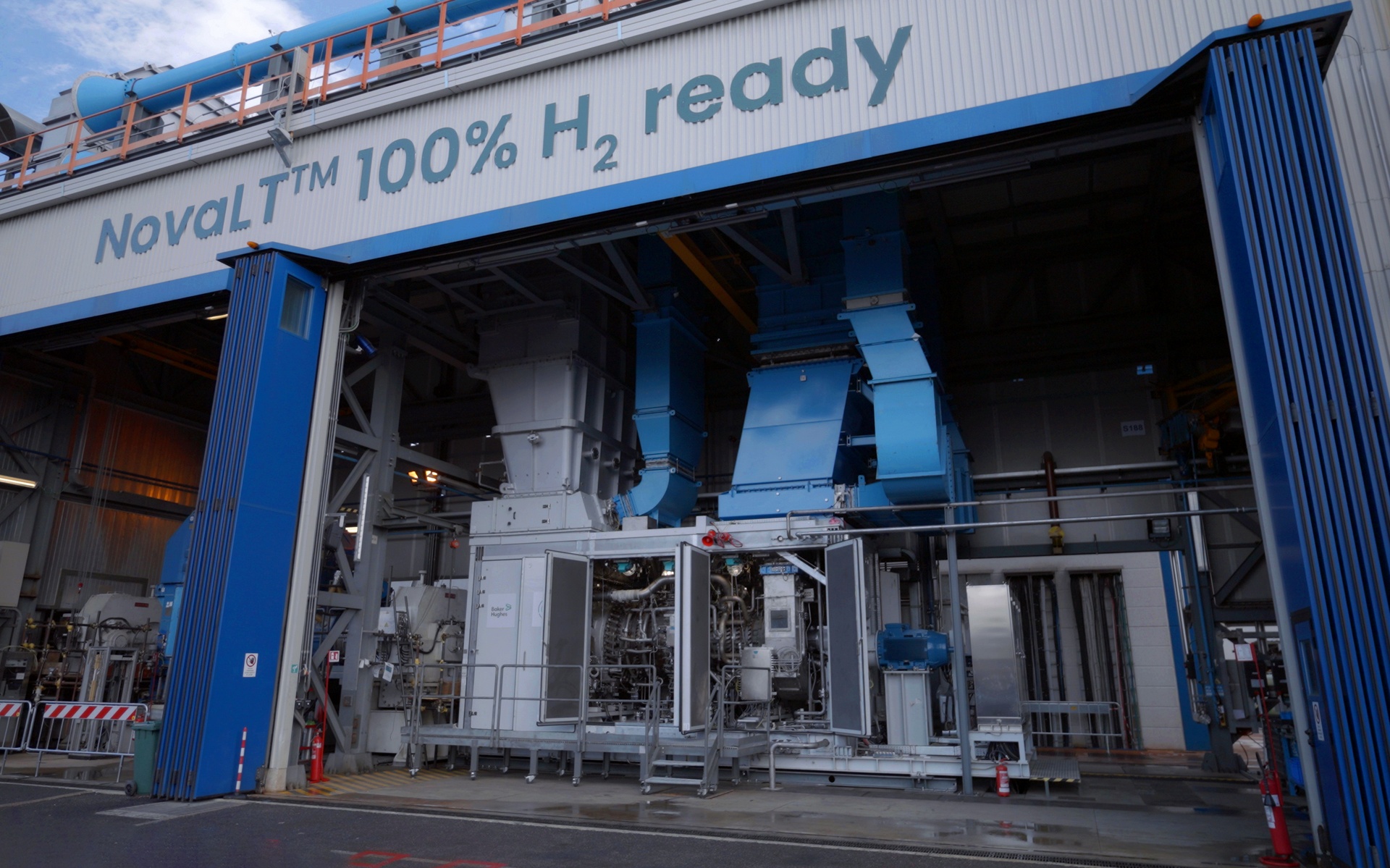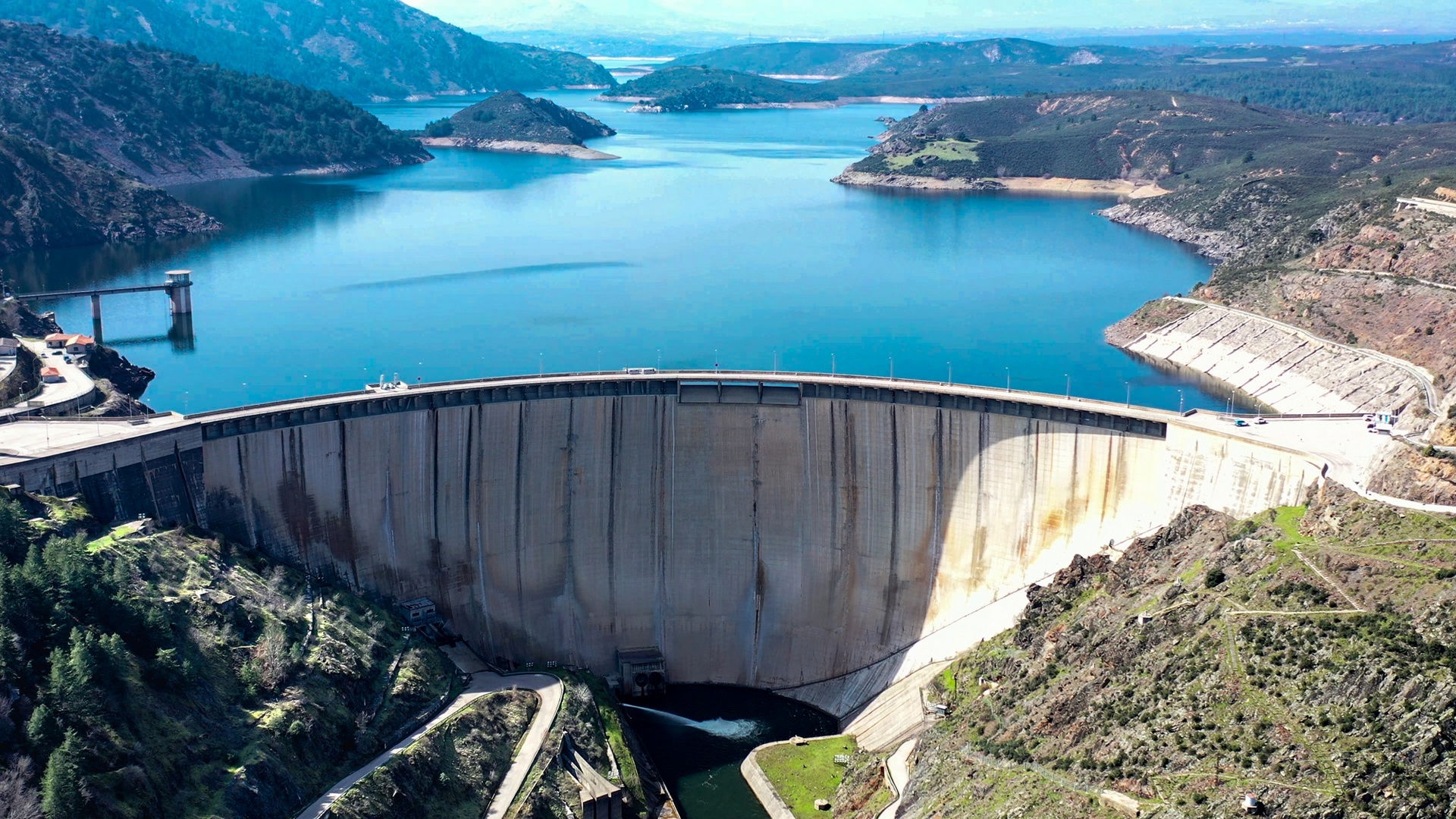
Global demand for energy is still growing, driven by population growth, deployment of AI and data centres, and rising power intensity across major developing countries. To meet this demand, we must leverage every source of energy with the best energy mix at regional level.
At Baker Hughes we take a portfolio approach to all climate technology solutions, recognizing there is no single answer but a co-existence of different solutions according to geographical constraints and policy supports.
Short term, the focus is on ensuring access to secure and affordable energy such as natural gas, which represents a key lever for reducing emissions, especially when combined with abatement and proven technologies.
Simply by leveraging existing technologies, upstream operators can reduce their emissions by as much as 70%. This includes highly efficient equipment like compressors, turbines, and pumps, alongside data management and AI for optimization.
In the medium and long term, alternative fuels like hydrogen and its derivatives will become increasingly central.
Priority is scaling alternative fuels
The primary consideration is therefore how to scale alternative fuels, like hydrogen. We believe investing in continuous R&D to drive innovation, paired with strategic partnerships to develop scalable solutions for hydrogen, is key to lowering costs.
In 2024 alone Baker Hughes invested $643M in R&D to deliver several advancements across our portfolio, including climate technology solutions for hydrogen production, transportation and storage, CCUS, emissions abatement and clean power solutions.
We participate across the entire hydrogen value chain, supporting customers from feasibility studies through technology provision to aftermarket services. Our decades of experience (started in the 1910s) with hydrogen, including over 2,250+ installed compressors (hydrogen specific) and wide experience burning hydrogen with turbine technology (over 70 projects worldwide), provides deep knowledge of materials and behaviours, allowing us to anticipate specific application needs.
Furthering the adoption of alternative fuels cannot solely fall on technology and project developers. Policymakers must share the responsibility to incentivize investment decisions through technology agnostic regulations. Policy is essential to overcome current barriers to alternative fuels and low-carbon technology adoption at scale. And scale is essential to unlock efficiencies able to increase alternative fuels competitiveness.
Three primary challenges
Across the market, Baker Hughes has identified three primary challenges in enabling the energy transition, though we view these not merely as obstacles but also as significant opportunities.
An interesting model countries could follow is China’s approach to launch its domestic hydrogen economy, particularly in the mobility sector. Their approach is built on some key pillars: a massive build-up of renewable power generation, delivering low-cost electricity, which is the main cost driver of H2 (60-70% of levelized cost of hydrogen derives from electricity price); a holistic commitment to technology innovation across the entire hydrogen value chain; the emergence of economically self-sustaining hydrogen projects in regions close to low-cost power combined with minimal transportation costs; and targeted support for end-users in big centres like Shanghai and Beijing.
Ensuring safety above all
The increasing use of new solutions such as hydrogen in various sectors where they were not previously implemented also underlines the absolute need for operational safety and, by extension, harmonized regulations and standards.
Linked to this, certification will represent a critical element as hydrogen and its derivatives scale up, and our collaboration with RINA will become invaluable.
We are leveraging RINA’s strong expertise in certification, regulatory frameworks, and sector knowledge, particularly in the maritime sector. This is highly relevant as we look to deploy innovative technologies and solutions in this space, such as our new small-size turbine for ammonia applications, developed in collaboration with Hanwha Power Systems and Hanwha Ocean. RINA’s commitment to fostering innovation through their Open Innovation Hubs (OIHs) further strengthens this synergy.
Alessandro Bresciani is Senior Vice President of Climate Technology Solutions at Baker Hughes, part of the Baker Hughes Industrial & Energy Technology business segment. The company provides solutions for energy and industrial customers worldwide, focusing on carbon capture, utilization & storage, hydrogen, emissions abatement, and clean power solutions.
Alessandro holds a degree in Industrial Engineering, and a Master’s Degree in Business Administration from SDA Bocconi. He has over 25 years of global experience in energy and industrial sectors, covering multiple roles including sales, commercial, operations, services, and business development. Prior to his current role he was Vice President, Services for the previously named Turbomachinery & Process Solutions business in Baker Hughes.
In his current role, Alessandro is responsible for defining the strategy and operationalizing product and solution management and project execution. He also sits on the Board of Directors of Nuovo Pignone International S.r.l. and is part of the RCS Academy Business School Advisory Board, as well as a supporting member of the Hydrogen Council.

On a lifecycle basis, nuclear energy has one of the lowest CO₂ equivalent emission rates, at 12 grammes CO₂-eq/kWh, comparable to that of renewables.
Nowadays, nuclear energy generates 24% of the EU’s electricity demand, or some 50% of the decarbonized power in the region. Therefore, nuclear power is already an essential part of European decarbonization pathway.
Looking at the future, according to recent studies (e.g. Pathways to 2050, Role of Nuclear in a low-carbon Europe – nucleareurope October 2024), more nuclear power would enable a faster decarbonization, and would drive down EU electricity prices.
Taking into account the life extension of the current NPP fleet and new realizations of large LWRs and SMRs/AMRs, a realistic scenario backed by the European Nuclear Alliance foresees an increase in nuclear capacity in the EU from today’s 100 GWe to 150 and even 200 GWe by 2050.
This would not only impact the decarbonization pathway, but also EU-27 economic output. In the 200 GWe scenario, the nuclear industry over 2025-2050 would support annually 1,667,000 full-time jobs and generate €71.9 billion of additional cumulated state revenues.
Change in European approach
In recent years, Europe has presented a fragmented nuclear landscape, with some countries heavily investing and others opting out. However, this changed in 2022 with the energy crisis triggered by the current conflicts in Ukraine and the Middle East.
In recent months we have seen several EU countries lifting their bans on nuclear energy and shifting to new, even aggressive, nuclear programmes. This is the case for Sweden, Belgium and Italy, as well as nuclear newcomers like Poland and Estonia.
Even countries traditionally against nuclear power deployment like Denmark are re-evaluating their long-standing ban, and I would not be surprised if in coming months even Germany reconsiders its anti-nuclear energy policy.
The case of recent blackout in Spain, which may have been triggered by excess of intermittent renewables on the grid and lack of inertia, deserves to be carefully investigated. Meanwhile, the Spanish Parliament recently approved the admission for consideration of a bill to ensure the continuity of nuclear energy in the country.
Bringing safety regulations up-to-date
European safety regulations must evolve to keep pace with the new nuclear technologies. Several ongoing initiatives in the EU and worldwide aim to streamline the certification and licencing process for new nuclear plants.
Even if the authorisation of nuclear installation remains the sovereign responsibility of the States, a cooperation between regulators on the pre-assessment of new nuclear technologies is considered valuable.
Stefano Monti is the President of the European Nuclear Society, whose main goal is to promote and advance science and engineering related to peaceful uses of nuclear technologies.
Stefano is also President of the Italian Nuclear Association and Chair of the Advisory Board of the Italian Joint Research Partnership on nuclear. He also assists the Italian Government within the National Platform for Sustainable Nuclear Energy, and the European Commission for the evaluation of EU projects of various Euratom Programmes.
Prior to this and between May 2011 to November 2022, Stefano was Head of the Nuclear Power Technology Development Section in the Department of Nuclear Energy of the International Atomic Energy Agency (IAEA).
From 1999 to 2006, Stefano was Scientific Secretary of the Italian National Agency for New Technologies, Energy and Sustainable Economic Development (ENEA) Scientific Council, and Scientific Advisor to the President of ENEA.
He has held many other positions in the international nuclear industry. Stefano
holds a doctorate in nuclear engineering
from the University of Bologna and is a professional licensed engineer.

Indonesia’s roadmap to reducing emissions is anchored in the 2025-2034 Electricity Supply Business Plan (RUPTL), which is the greenest in the country’s history.
The Plan targets the addition of 42.6 Gigawatts (GW) of new renewable energy generation and 10.3 Gigawatts (GW) of Energy Storage, which will account for 76% of the total new generation capacity.
In the 2025-2034 Plan, the 42.6 GW of renewable energy consists of 17.1 GW PV, Hydro 11.7 GW, Wind 7.2 GW, Geothermal 5.2 GW, BioEnergy 0.9 GW and 0.5 GW Nuclear.
Meanwhile, the 10.3 GW storage consists of 6 GW Pump Storage and 4.3 GW BESS. Some of the key technologies that we believe will be game-changers in Indonesia’s energy transition are Smart Grid and Energy Storage Systems (ESS), Biomass Co-firing, and Carbon Capture, Utilization, and Storage (CCUS).
A unique geography
Indonesia’s unique geography presents particular challenges when it comes to the integration of renewable energy into the national grid.
Grid stability and energy storage are crucial. Given Indonesia’s archipelagic geography, our strategy is multi-layered, with:
High voltage submarine cable technology
Underwater infrastructure is key in an island nation. To ensure efficient distribution, we have implemented High Voltage Submarine Cable Technology (HVDC/HVAC), both direct current (HVDC) and alternating current (HVAC).
This enables us to transfer large amounts of power with minimal losses between islands (Sumatra to Java, Sumatra to Batam to Bintan, Kalimantan to Java, Kalimantan to Sulawesi).
In addition, we have started adopting digital twin technology for critical infrastructure such as submarine cables. This allows us to monitor structural integrity, perform predictive maintenance, and ensure long-term safety and resilience against risks such as seismic activity or marine traffic.
The design and installation of our subsea infrastructure takes into account the complex geological and oceanographic conditions in Indonesian waters to ensure operational resilience.
The energy transition presents a unique set of opportunities and risks for a country like Indonesia.
For the former, we can highlight the job creation opportunities in the renewable energy sector. Renewable energy plants such as hydro and geothermal, which are often located in remote areas, also promotes local infrastructure development and increases electrification in these areas.
Overall, Indonesia will also improve its energy security and independence by reducing dependence on imported fossil fuels.
Ensuring energy affordability
The risks are centred on energy affordability, and the transition must not burden the public with high electricity tariffs. The country must also ensure a balance between the retirement of fossil plants and the readiness of new RE plants to avoid a supply crisis. There is also some supply chain risk with the imported technologies needed for some renewables.
To track and measure the country’s greenhouse gas emission reductions, we have a structured monitoring, reporting and verification (MRV) system.
The most important indicators are: Emission Intensity (tCO₂e/MWh) which is our key metric; the Renewable Energy Mix by percentage; and the Absolute Emissions Reduction (tons CO₂e), which tracks total GHG emission reductions from various initiatives. Finally, we have the Realization of PLTU Early Retirement Program, which shows the amount of power plant capacity that we successfully retire on schedule.
To ensure security of supply while pursuing sustainability goals, we will continue to rely on gas as a transition energy that is cleaner than coal. The biomass co-firing program also plays an important role in reducing the carbon footprint of existing power plants while waiting for large-scale renewable energy plants to be fully operational.
We are also actively building a domestic biomass supply chain to support this program and create a circular economy ecosystem.
Partnering with RINA
Collaboration with an international partner that has proven expertise like RINA can add significant value to the whole process. We see great potential in several areas, including certification where RINA’s expertise in certification helps us ensure that our RE projects meet the highest international standards, which is important to for investor and stakeholder confidence.
RINA’s experience in engineering renewable energy projects worldwide, including offshore and underwater technologies, can also help us in the design and implementation phase of complex projects such as offshore wind farms or subsea interconnections, while RINA’s expertise in risk analysis and infrastructure resilience engineering is invaluable given Indonesia’s geographical risks.
Ricky Cahya Andrian is the Vice President of Decarbonization Business Development and Energy Management at PLN Indonesia, the state-owned electricity company.
Ricky has over 20 years’ experience in the planning, operations and maintenance of Power Systems and HV Substation Systems.
He is also closely involved in Green Hydrogen Production, Storage, Distribution and Utilization at PLN, which is the leader in Green Hydrogen Ecosystems in Indonesia.
Ricky is also Chairman of Smart Energy Society, and a member of the association Fuel Cell Hydrogen Energy (IFHE), Indonesia.
He is an electrical engineer by background.

Climate action is one of the top priorities of the European Investment Bank Group (EIB). As the European Union’s public bank, our lending criteria are directly shaped by EU policies. For instance, we no longer finance unabated fossil fuel energy projects, and we require all investments to be in line with the Paris Agreement on climate change.
The EIB has taken a pioneering role in sustainable finance, most notably by issuing the world’s first green bond, the Climate Awareness Bond, in 2007.
The bank continues to innovate in sustainable finance instruments, for instance via a landmark € 3 billion Climate Awareness Bond under the new European Green Bond Standard. This attracted investor demand of over € 40 billion and was oversubscribed 13 times.
These instruments are setting standards that many others follow, as we consolidate our role as “the Climate Bank”.
Private capital expands in green space
Private capital is playing an increasingly pivotal role in Europe’s decarbonisation, with investors directing funds toward sectors that promise both strong environmental impact and attractive financial returns.
Battery recycling and green hydrogen are particularly prominent, as they align closely with EU climate targets and benefit from supportive policy frameworks and public-private partnerships.
In battery recycling, private equity and venture capital are backing advanced technologies that support the circular economy, while green hydrogen is drawing significant investment thanks to ambitious EU production targets and de-risking measures that help overcome early-stage challenges.
Beyond these, private investors are also focusing on offshore wind and ocean energy, as well as industrial decarbonisation in sectors like steel and chemicals.
These areas are gaining traction due to clear regulatory support, innovation finance tools, and the growing maturity of technologies, which together reduce risk and increase confidence.
Overall, Europe’s sustainable transition is becoming more investable as enabling ecosystems - combining policy, finance, and innovation - make it easier for private capital to support the continent’s green ambitions.
The right risk-return
We believe Europe’s ambitious decarbonisation goals are both sustainable and pragmatic from a financial risk-return perspective. When the right enabling conditions are in place - such as clear policy signals, robust regulatory frameworks, and targeted de-risking instruments - private capital is willing to engage, even in emerging or capital-intensive sectors.
We have seen this in practice: in 2024, nearly 60% of EIB Group financing supported climate action and environmental sustainability, putting us on track to achieve our goal of supporting €1 trillion in green investment by 2030. Institutions like the EIB Group play a crucial role in bridging policy ambition with market reality.
Emmanuel Chaponniere is Head of Division in the Projects Directorate of the European Investment Bank (EIB), the long-term lending institution of the European Union. He is responsible for Circular Economy and Sustainable Development.
The directorate is composed of sector specialists and is tasked with project appraisal, the monitoring of project implementation, sector studies and policy development.
Prior to joining the EIB, Emmanuel Chaponniere worked as a water sector specialist as well as a waste expert in Europe and Africa. He graduated from the École Nationale Supérieure de l’Aéronautique et de l’Espace (France) and holds a Master’s degree in Water Management from the École nationale du génie rural, des eaux et des forêts (France).
Reflecting the growing importance of the circular economy, the EIB Group provided a total of € 5.5 billion across approximately 153 projects between 2020 and 2024, split between Industry and Services (40%), Agri-forestry and Bioeconomy (29%), Waste Management (12%), and Urban Development & Buildings (11%). The Bank plays a key role in advancing the circular economy by financing operations focused on material recovery and recycling.